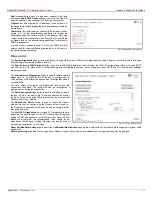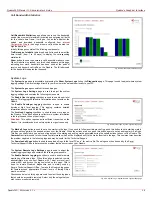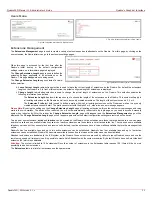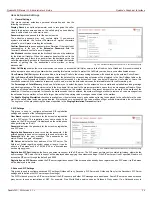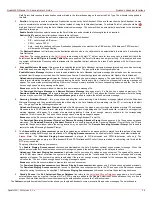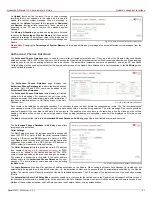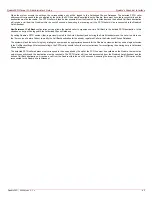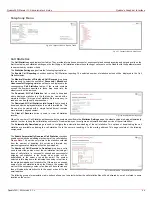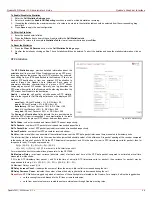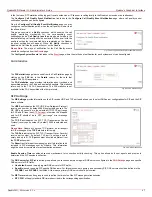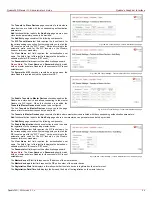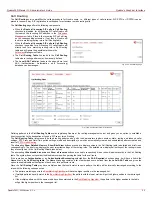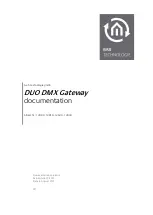
QuadroFXO Manual II: Administrator's Guide
Quadro's Graphical Interface
QuadroFXO; SW Version 5.1.x
40
The Extension Codecs page displays a list of Codecs with the
state of the Out of Band DTMF and FAX Support features for
Quadro extensions and the Auto Attendant.
Please Note:
Use caution when configuring Auto Attendant
Codecs as they are used by virtual extensions for redirecting the
incoming calls.
The table Codecs lists active voice codecs for the selected line
that are supported by Quadro. The order of records in the Codecs
table is important for transmitting and receiving. A codec placed at
the top of the table will be used as the preferred codec. If the
remote party does not support the preferred codec, the following
codecs will be tried in a top to down order in the Codecs table.
Each record in the table has an assigned checkbox. They are
used to select the record to be deleted or moved up or down.
An error occurs if no records are selected and the user activates
the delete button, the “No records selected” error message
appears. At least one codec must be attached to the line. When
attempting to delete the last codec, the “At least one codec should
stay in the codec list” error message will appear.
Enable/Disable functional button is used to enable or disabled the
corresponding codec for the extension. When the codec is
disabled, the extension user will not be able to use it for placing a
call.
The Move Up/Move Down buttons are used to move the selected
codec one level up/down in the table.
Fig. II-72: Extension Codecs list
The Make preferred button moves the selected codec to the top of the table, setting its priority to the highest. Clicking the Make preferred button
when a disabled codec is selected will first enable the codec and then move it to the top.
The Out of Band DTMF Transport checkbox enables DTMF code transmission in parallel with the voice stream. The destination receiving the
DTMF code will play it locally if it supports the feature. This is helpful to avoid DTMF’s loss upon bad traffic. This feature is valuable for all codecs but
it is especially recommended to enable it in case low bit rate codecs (G.729, G.723, G.726/16, etc.) are selected.
Enable T.38 FAX checkbox enables the FAX tone detection and the T.38 codec support for the FAX transmission from/to the FAX machine/modem
attached to the line. It also enables the T.38 codec support for incoming unified FAX messages.
The Enable Pass Through FAX checkbox enables the FAX tone detection and the G.711 codec support for the FAX transmission from/to the FAX
machine/modem attached to the line. It also enables the G.711 codec support for incoming unified FAX messages.
If both of the above checkboxes are enabled, the T.38 codec will be used as a preferred codec for FAX transmission. If it is not supported by the
peer, the G.711 codec will be used instead. If the extension is attached to the line that has no FAX machine/modem connected (the extension is
virtual), the incoming FAX can only be stored in the extension's voice mailbox. To allow FAX to be stored in the voice mailbox, the extension's user
should not answer the incoming calls, so that they are forwarded to the voice mailbox.
Please note:
If both of the above checkboxes are disabled, no FAX transmission to the peer's voice mailbox will be possible.
Enable Pass Through Modem checkbox is only available for Auto Attendant and extensions attached to the FXS lines. This checkbox enables the
modem tone detection and the G.711 codec support for the data transmission from/to the modem attached to the line. During data transmission,
Silence Suppression (see
) and Echo Cancellation are being disabled on the line.
Please note:
If the extension/attendant is intended to accept modem connections, disable the Enable T.38 FAX checkbox to allow the system to
identify the modem tones correctly. Otherwise, the modem connection may fail.
The Force Self Codecs Preference for Inbound Calls
checkbox enables the usage of your own preferred codecs (if available on both peers) for
the IP connection establishment on the extension.
Upload Universal Extension Recordings
The Upload Universal Extension Recordings are to be defined by the Quadro administrator and will be present instead of the default voice
messages for all extensions on the Quadro. They will be used when no custom messages have been uploaded or recorded.
The following system messages can be uploaded from this page:
•
Incoming call blocking - played when a blocked user calls the extension
•
Outgoing call blocking – played when extension dials a blocked destination
The Upload Universal Extension Recordings page consists of a table where the universal voice messages are listed.


